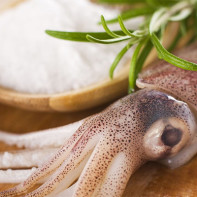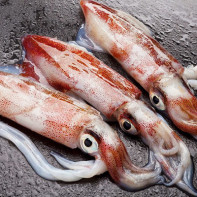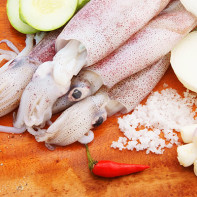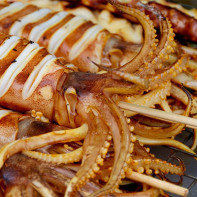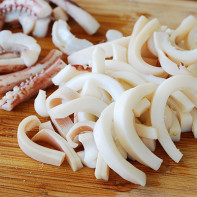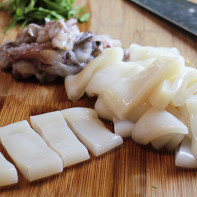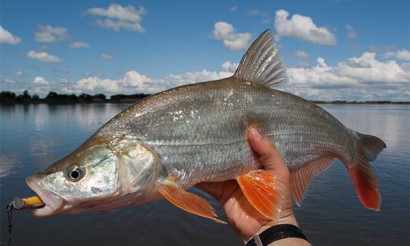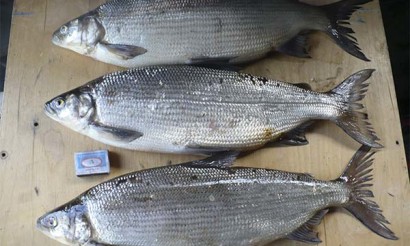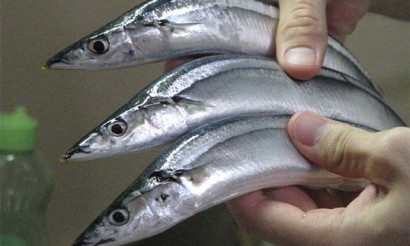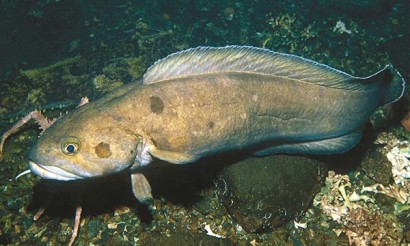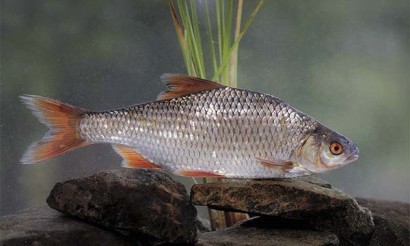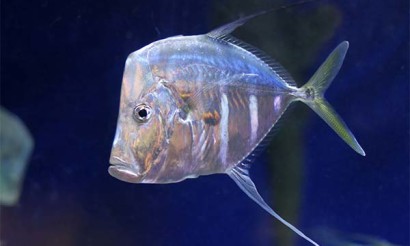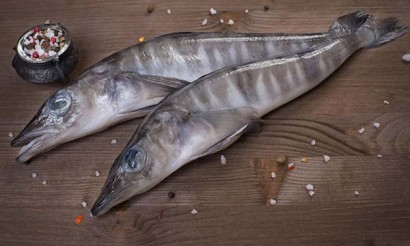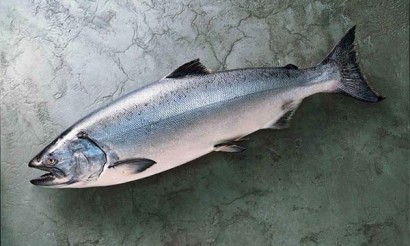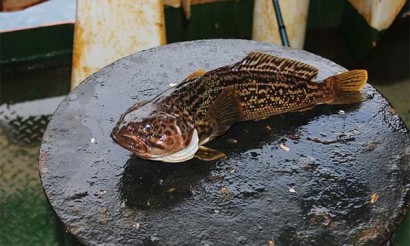What are calamari useful for men and women? Recipes for cooking
The benefits of seafood for human health is undeniable. They have a high concentration of minerals, they are also rich in iodine, the lack of which leads to serious health problems. And the squid clam is one of the easiest to prepare, tasty and affordable seafood.
- What is a squid and what does it look like
- How squid differs from octopus and cuttlefish
- Composition and calories
- How Calamari is useful
- General benefits
- For Women
- For Men
- Breastfeeding
- For Pregnancy
- For children
- The benefits and harms of dried squid
- Can I Eat Calamari when Losing Weight
- Squid in Medicine
- Diabetes mellitus
- For pancreatitis
- For gastritis
- For gout
- For colitis
- Cholecystitis
- Hazards and contraindications
- How to choose and store squids
- How to quickly peel squid from the foil
- How to cook squid delicious
- How to Fry
- How to boil
- How to Dry
- How to marinade
- Squid Salad
- Squid cutlets
- Why squids are bitter after boiling
- Can I Eat Squid Caviar
- Can I eat squids during Lent?
- Can I give squids to animals?
- Interesting facts about squids
What is a squid and what does it look like?
Squids belong to the cephalopod mollusk family, with lengths ranging from 20 to 50 cm. They are caught in every climatic zone, but most often they are found in the subtropics. Squids of the northern seas are often not very big in size and do not have a characteristic coloring compared to their "relatives" from the southern zones.
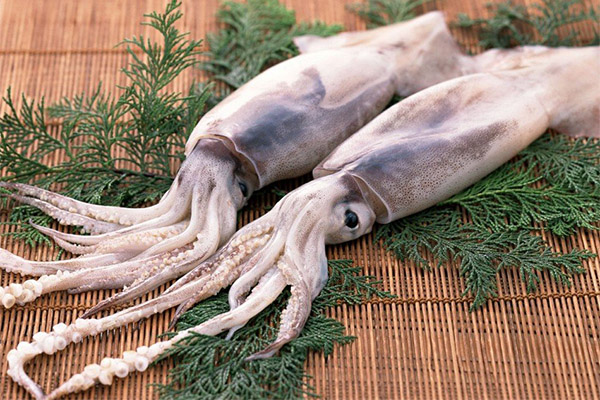
Due to the streamlined shape of their bodies they are able to move at a very high speed with their tail forward. Almost all of the existing species of these mollusks are suitable for food, which contributes to their active production. Squid tentacles and squid carcasses are suitable for eating. The skin is removed.
How squid differs from octopus and cuttlefish
From octopus squid differs in the number of limbs. The octopus has eight limbs, and the squid has two more tentacles with flat ends. The head of the squid is separated from the body, while the octopus is completely fused with the body. To a greater extent, the latter settle on the bottom and prefer to crawl, while squids swim very fast.
The cuttlefish, like the octopus, has eight tentacles, and its body is oval and bordered by a circular fin. The body of a squid is torpedo-like, with two rows of suction cups on the tentacles.
Composition and calories
The main value of squid meat is the high concentration of protein: in 100 grams of product there is up to 18 g of protein. Protein is the building material for all cells and tissues of the body, it is necessary for the transformation of amino acids, including essential ones. Without them the normal functioning of any organ is impossible.
The caloric value of squid is about 100 kcal per 100 g. Carbohydrates account for not more than 3 g and fat - 1.4 g.
Calamari, like many other seafood, is different in that it includes almost all the vitamins and minerals the body needs. These are B vitamins (B1, B2, B6), ascorbic acid, vitamin E, manganese, iodine, phosphorus, iron, zinc, copper, selenium and calcium.
How Calamari is useful
General benefits
The unique properties of squid:
- Just 80 grams of squid contains up to 90% of the daily allowance of copper. This is a mineral without which normal absorption of iron, hence the formation of red blood cells, is impossible. One of the common causes of anemia is considered to be copper deficiency.
- Selenium is one of the best antioxidants that successfully fights free radicals. It can significantly reduce the symptoms of rheumatic arthritis, including levelling the pain. In 100 grams of squid - 60% of the daily norm of selenium.
- Because of the high concentration of vitamin B2 (riboflavin), adding squid to the diet can reduce the manifestation of migraine.
- The product contains calcium and phosphorus that reinforce each other and are responsible for the formation of bone and tooth tissues.
- The seafood is also rich in vitamin B12, one of the tasks of which is to reduce the level of homocysteine in the body. If its concentration in the blood exceeds the allowable level, it can lead to heart attack, stroke and other cardiovascular diseases.
- Magnesium, present in squid, is responsible for relieving muscle spasms and relaxing the nervous system.
For women
For women, squid is primarily useful because it is a natural source of easily digestible protein. It provides healthy skin, hair and nails. Also in the clam there is a high concentration of Omega-3 and Omega-6 fatty acids, which play a huge role in maintaining women's health. In addition to supporting natural beauty and promoting longevity, these substances are also responsible for the production of the hormone serotonin and strengthen the immune system.
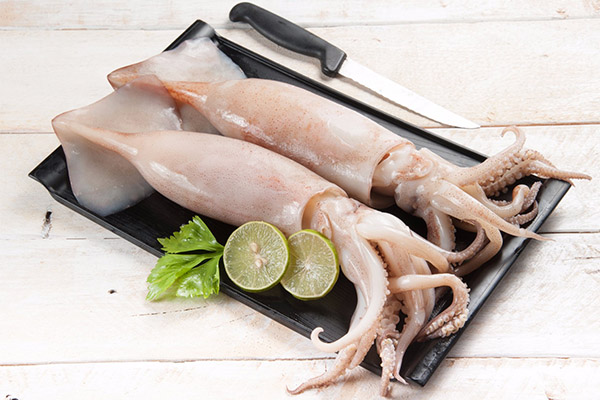
For men
For men, calamari can be valuable in another way - promoting fast and safe muscle growth and strengthening the body. That is why it is definitely worth paying attention to for athletes. In addition, the clam has a favorable effect on men's health by increasing potency. Men who regularly consume this seafood note the stabilization of the genitourinary system and an increase in testosterone in the blood, feeling full of strength and energy.
During breastfeeding
When breastfeeding, it should also be abandoned because of the risk of allergies in the newborn. It is manifested by rashes and diathesis. If a woman has not noticed an intolerance to squid before pregnancy, you can try to introduce it into your diet. But it is necessary to wait until at least 6 months, or better - to postpone for a year.
In pregnancy
During pregnancy, squid can also be present in the diet, but the fundamental importance is the region in which it was caught. Most water bodies are polluted with industrial waste, and these in turn accumulate in the tissues of seafood. Therefore, you must either be 100% confident in the environmental safety of the product or still do not take the risk.
For children
Children can eat calamari only after three years and in the absence of individual intolerance. Its meat will serve as an excellent source of minerals and amino acids. It has a positive effect on memory and mental development. Protein stimulates the growth of the child, and calcium ensures the perfect condition of teeth and bones. But before introducing the product to the children's menu, it is better to consult a doctor.
Benefits and harms of dried squid
Dried squids belong to the category of "snack-snacks", so they are incredibly popular among young people and as a supplement to beer. But their inordinate consumption can provoke the deposition of salts, which in turn leads to fluid stagnation.
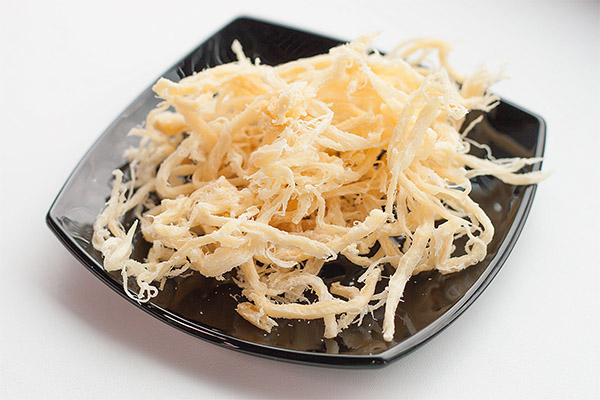
The benefits and harms of them directly depend on the technology of production. Most manufacturers do not comply with the elementary norms of preparation of the product. For example, when defrosting, the mollusk should not remain in water for a long time: if it is pulled out quickly, it will contribute to the preservation of all the main nutrients and vitamins. After the squid is washed in cold water, cooled, cut and sorted. The final step is the treatment with monosodium glutamate. This is a flavor enhancer, which in large quantities can provoke food poisoning. Its constant use may aggravate chronic diseases, including cancer.
Moreover, many companies involved in the production of dried squid in recent years have begun to treat them with oil, which increases the concentration of carcinogenic substances.
Nevertheless, it is not necessary to refuse dried squid completely. You only need to read the label. If sorbic acid is listed among the ingredients, then such a product will not be harmful to the body, as it is a safe and internationally recognized preservative.
Is it possible to eat squid when losing weight?
Since squid contains a lot of protein, it is excellent for satisfying hunger. At the same time, it is almost completely free of fat, which makes it an excellent dietary product. The extractive components present in the clam affect the production of gastric juice, which contributes to the proper functioning of the entire digestive system. In the fight against extra pounds, this seafood also helps:
- remove cholesterol from the body;
- to remove swelling of tissues;
- Improve metabolic processes, which leads to weight loss.
But when switching to a proper diet, it is possible to use squid only in boiled or steamed form.
Squid in medicine
Due to the huge number of micro- and macronutrients, vitamins that make up the squid, it is often recommended for use in many chronic diseases.
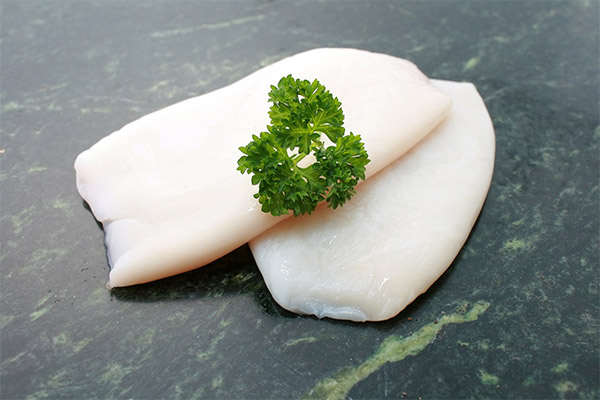
For diabetes mellitus
The product will be extremely useful for diabetes mellitus. This is due to the fact that it contains vitamin B3, one of the properties of which is to normalize sugar levels. The glycemic index of squid is only 5 units, i.e. it is absolutely safe in terms of the probability of sugar increase. The protein of seafood is much better assimilated than meat or fish, this is one of its main advantages. But it is not necessary to switch completely to squid. It is enough to add them to the diet 1-2 times a week. This will allow the patient to fully saturate the body with vitamin PP and E.
In case of pancreatitis.
And in the case of acute pancreatitis, squid should be completely excluded from the diet, even despite the negligible percentage of fats in their composition. The ban is due to the content of substances that increase the secretory function of the pancreas. Since squids are recognized as allergens, they can also increase the course of pathological processes, which will provoke a general deterioration.
With chronic pancreatitis in remission, they can be added to the menu, but only in a boiled form. Allowed method of cooking - bake, stew, add to vegetables or in salads.
Gastritis
People who suffer from gastritis, provided there is no individual intolerance, should definitely diversify their diet with this delicacy. It is a soft meat, which can not damage the inflamed walls of the stomach, while it serves as a more effective substitute for animal protein and eggs. But you can eat only boiled or stewed meat. Dried, fried or pickled calamari must be abandoned.
In gout
If gout is not in the acute stage, squid will be an excellent source of vitamins and minerals and will help in the fight against the disease. Included Omega-3 acids are effective with inflammation of any localization. With the same problem will fight iodine. The carcass is best baked, steamed or stewed, but not fried. Broth in which the squid was boiled can not be eaten, because it just remains all the purines.
In colitis
In colitis (pathological inflammation of the mucosa of the large intestine) requires strict adherence to a diet. But it allows inclusion in the menu and seafood, including calamari. Again, because of the richest composition and at the same time easy digestibility it will not bring any potential harm to health and will not aggravate the course of the disease. It can be added to the diet in any form of cooking except frying.
In cholecystitis.
Cholecystitis also involves certain dietary restrictions, but seafood is allowed. Calamari will not provoke choleretic action, thereby increasing the load on the inflamed bladder. They should be steamed, boiled or baked, but not crusted fried.
Harms and contraindications
Recently, there are more and more official studies confirming the high concentration of mercury and other heavy metals in fish and seafood. They accumulate in the water due to industrial emissions, which are only increasing every year. According to the Environmental Protection Agency, squid is one of the few foods with minimal ability to accumulate mercury.
But the shellfish is among the biggest allergens. Many people have been clinically determined to have an intolerance to calamari, manifesting as an allergic reaction.
How to choose and store squids
It is best to buy frozen squid. Defrosted ones, especially if not properly handled, are bitter and don't hold their shape. It is essentially a reject that has no nutritional or flavor value. The carcasses should not be sticky, because that, too, indicates that you are facing a defrosted product.
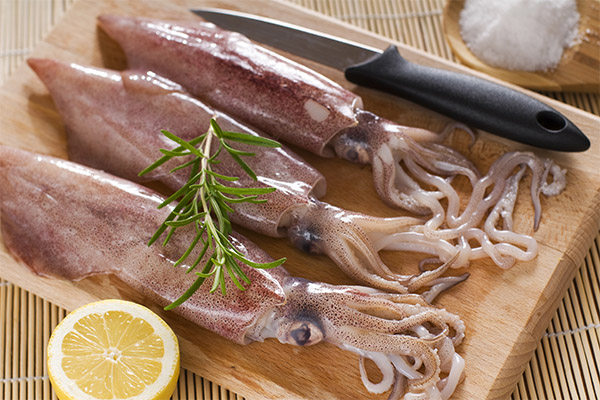
The body is always covered with a film, which depending on the habitat of the mollusk can have different shades - from gray to deep purple. And the meat of all varieties has a snow-white tint. Any other color is a signal of poor quality. Theoretically, it is possible to buy peeled squids, but this will immediately spoil the taste of the final dish, because such meat is absolutely tasteless.
There is a little secret that can be guided when choosing these seafood: the smaller the size, the tastier the meat.
Squids should be stored only in the freezer. Without the need, they should not be thawed and frozen again.
How to peel squids from the film quickly
To quickly peel them from the film, you do not need any special devices. It is enough to put the frozen mollusk in a bowl and pour it with steep boiling water. Due to the temperature difference almost all the film on its surface curdles and is easily detached. The film that has not come off can be easily removed by hand.
Then it's necessary to drain the water and rinse the body under running water. You should also remove all the insides of the squid, including the transparent backbone, and rinse it again. If after all these processes the meat has not had time to defrost completely, you need to pour hot water (but not boiling water) and leave for a few minutes.
How to cook squid deliciously
Today there are a huge number of recipes based on squid. They are suitable for making both daily and holiday menus.
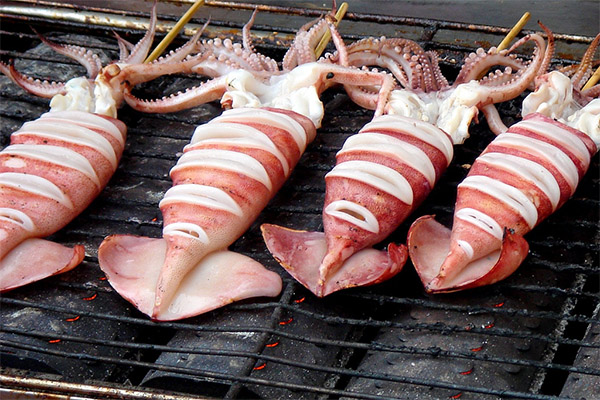
How to fry.
If there are no problems with the gastrointestinal tract, you can periodically indulge yourself with fried squid. For this you will need:
- frozen squid - 300 grams;
- soy sauce - 5 tablespoons;
- salt - to taste;
- white dry wine - 120 ml;
- grated ginger - to taste;
- dill - 2-3 sprigs;
- olive oil or sunflower oil - 3 tablespoons;
- sugar - 1 tsp;
- juice of half a lemon.
First of all thaw the calamari, rinse thoroughly and take off the foil. Cut the carcass into 4-6 pieces depending on its size. In a separate bowl, mix wine, soy sauce, lemon juice, grated ginger, sugar, add finely chopped dill. Mix everything until the sugar is dissolved. Dip calamari in this marinade and leave in the refrigerator for 60 minutes. After that, heat a frying pan, pour oil and lay calamari on it. We fry over moderate heat for 10 minutes.
How to boil
The best way to cook squid is to boil it. To do this, sliced meat or a whole carcass should be placed in salted water with the addition of black pepper and bay leaf. Boil it no longer than three minutes, otherwise it will be rubbery. Again you can return it to softness only if you boil it for 30 minutes. But in this way, its quantity will be reduced by exactly half. After that, you can do anything you want with the clam - cut it up for salads or stuff it.
How to Dry
You can make a good snack out of calamari at home. Unlike store-bought, it will not have any flavorings and flavor enhancers that are dangerous to health. All you need for its preparation: a squid carcass, salt, pepper and the oven.
The sequence of operations should be as follows:
- Frozen clam carcass put in a bowl of water and leave to thaw. Pour out the water and rinse thoroughly under running water. If you want to cook fresh squid, you should just rinse it in water.
- Dismember the carcass. Tentacles are separated from the sirloin part, take out the chord and all the insides and wash everything again. Remove the foil (to do this you need to put boiling water on the squid).
- Before drying soak the product in salt water. There are several ways to do this. In the first case, immerse the carcass in a weak salt solution and leave it in it overnight. If there is no extra time, you have to make a solution that is used in the North for salting caviar. The proportions are as follows: 1 glass of salt per 1 liter of water is required. We dissolve salt and immerse the clam in the resulting brine. Dip small pieces of squid in it for a few minutes.
- Dry in any way you want. In Asia, the technology of air drying is widespread. This is a good solution for owners of villas or country houses. In this case, the carcass does not need to be cut into pieces, but the whole dipped in the solution and then hung on hooks. In summer, the squid will dry for several days. A more practical option is to dry the meat in the oven. Small pieces should be dried on a towel, which will absorb the rest of the brine, and spread in a single layer on a baking tray. Remove to the oven for 3 hours at a constant temperature within 50 degrees.
How to marinate
Since calamari can be prepared in a variety of ways, including grilling, let's consider a universal method of marinating it. In addition, these calamari will also make a great appetizer in their own right.
Ingredients:
- calamari - 2-3 pcs;
- vegetable oil (olive oil is better) - 1 tbsp;
- lemon juice - 3 tablespoons;
- bay leaf - 2 pcs;
- water - 1 liter;
- sugar - 1 tsp;
- salt - 1 tsp.
Prepare the clam beforehand - take off the membrane and sort out the entrails. Cut the carcass into strips or rings. To get the brine, add a bay leaf, sugar, salt, lemon juice, vegetable oil, you can add any spices to taste. Boil the brine and put the meat in it. Turn off the heat, cover and let it stand under a lid. Ideally, the squid should be kept in the refrigerator for 18 hours. But if necessary, they can also be served a few hours after cooling.
Squid Salad
A recipe for a simple calamari salad that doesn't require much prep work.
You will need:
- Squid - 1 carcass;
- egg - 1 pc;
- fresh cucumber - 1 pc;
- Leek - 1 stalk.
Boil the egg, cut into small cubes. Squid and cucumber cut in julienne, chop onion finely. Mix all ingredients in a bowl and dress with low-fat yogurt. Decorate the dish with boiled shrimps. Such a salad can be a full breakfast. It is worth paying attention to those who suffer from excess weight and want to switch to a healthier diet.
Squid cutlets
Another original way to prepare the meat of this amazing mollusk - to make from it appetizing cutlets. For this you will need:
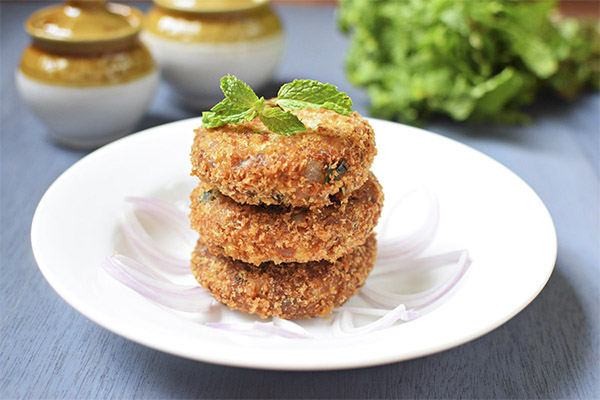
- calamari - 4 pcs;
- Dutch cheese - 200 grams;
- onion - 1 pc;
- dill - 4 sprigs;
- rosemary - 2 sprigs;
- Butter - 120 grams;
- Garlic - 2 cloves;
- eggs - 2 units;
- vegetable oil - 3 tbsp;
- breadcrumbs - 200 grams;
- salt, pepper - to taste.
Step by step recipe:
- Dill and rosemary chop thoroughly, transfer to a bowl and pour vegetable oil (olive or sunflower). Stir and pour the resulting mixture into the molds for ice and put in the freezer.
- Wash and peel the squid beforehand into small pieces and mince together with onions. Add the eggs and chopped garlic cloves to the minced meat. Shred the cheese with a fine grater and transfer it to the minced meat. Salt and pepper it.
- Roll a small amount of minced meat in your hands, so that you get patties. In their center we put one cube of previously prepared mixture of greens and butter and roll in breadcrumbs. Fry the cutlets on a well heated skillet in sunflower oil for 2 minutes on each side.
Why the calamari are bitter after cooking
Very many housewives are faced with the fact that squids are bitter after cooking. This is due to improper technology of their preparation. In particular, if it is not cleaned properly and not washed. It can also be bitter if it cooks too long. The initial poor quality of the product (repeated defrosting or poor packaging) can also negatively affect the taste of the meat.
One way to remove the bitterness is to cut the carcass into small slices and fry them in a little oil. You can put a little salt on it.
The meat of a giant squid can also be bitter. This is a specific kind of seafood, so you can not remove it completely.
Is it possible to eat squid caviar
Shellfish, like many fish, also have caviar. And squid is one of them. Most often it is not used in any way, but this is mostly due to the fact that people do not know how to cook it properly. The preparation requires the caviar of one or more squid, which should be washed under the faucet and then sprinkled with the juice of a lemon. Then leave it for a couple of minutes to soak, then rub it with a mixture of salt, pepper and oil. Then put the product into a baking dish. Caviar cooks quickly enough - for 20 minutes at a moderate temperature (about 150 degrees). Before serving it to the table, it is desirable to cool.
According to the same technology you can also roast caviar. You need to do the same, but do not bake in the oven, and form small neat balls and fry them in a pan with butter or olive oil. To make a nice crust, the pan should be heated as much as possible initially, and after laying the product the fire should be turned down to medium.
Fresh squid caviar has a rather specific taste, but if you want it can be presented as a separate snack. It can be strengthened with salt and pepper. Such caviar can also be used to decorate salads or added to them as one of the ingredients.
Can you eat squid during Lent?
If you observe the Lent in all its strictness, squid, as well as any other seafood, can be eaten only on days when fish is allowed. And these are Palm Sunday and Annunciation. But in the Greek Orthodox Church all seafood is allowed everywhere. This is due to the fact that in the Greek canon they are equated with sea plants, and they are allowed to be eaten on Saturday and Sunday, when oil is also allowed.
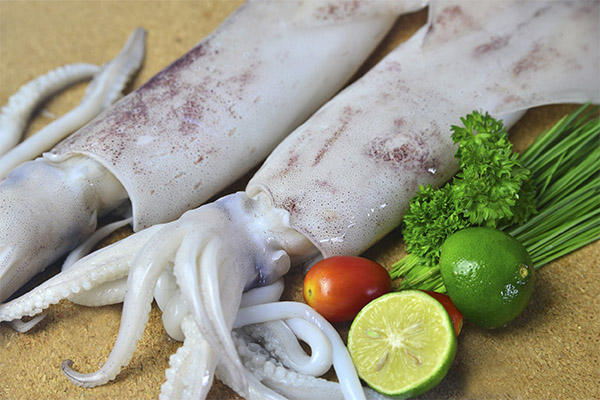
In the statutes of the Russian Orthodox Church there is no direct prohibition on their use, so it is better to discuss this matter with your confessor. Some priests allow their parishioners seafood on major church holidays, if they do not fall on Holy Week.
Can I Give Squid to Animals
Many pet owners wonder if their beloved pet will benefit from squid meat. Cats are undoubtedly considered the great connoisseurs of seafood. But here we must remember that there are 250 mg of phosphorus per 100 grams of squid. Its excessive amount in the cat's diet can provoke urolithiasis. Therefore, some veterinarians strictly prohibit any seafood. In addition, an excessive amount of them will certainly cause allergies.
But in small quantities and not more than once a week, this shellfish will still be useful for the animal. Ideally, it should only be boiled, no other forms of cooking are acceptable. Especially harmful are smoked or salted squid.
Since squid is not inferior to beef in terms of protein and amino acids, it is a worthy alternative that can be in the dog's diet. Beforehand, it is necessary to check whether the pet is allergic to the product. If it is not confirmed, you can gradually add it to the diet, starting with 50-250 grams per day (depending on the breed and size of the dog). Overfeeding with seafood is not allowed, so in this matter the rule "less is better, but better" is relevant.
Interesting facts about squids
Lovers of seafood will be interested in the following information:
- Squids are the least studied inhabitants of the seas, with more than 300 varieties of squid officially confirmed, but more than 200 more species remain unidentified.
- Of all the cephalopod mollusks, which also include cuttlefish and octopus, the squid is the most favorite of the marine predators.
- It is the squid that accounts for most of the diet of many members of the underwater world.
- Squids themselves feed on crustaceans and small fish. In the absence of those, they can switch to small representatives of their species.
- If a squid encounters a danger on its way, it emits a pigment very similar to ink.
- Some squids have the amazing ability to fly.
- In terms of speed of movement squids are surpassed only by dolphins, sharks and whales.
- The blood of the mollusk is blue in color, for the circulation of which not one, but three hearts are responsible.
«Important: All information on this site is provided for informational purposes only. information on this site is for informational purposes only. Check with your health care professional before using any of our recommendations. health care professional before using any of the recommendations. Neither the editors nor the authors shall be liable for any possible harm caused by materials."

